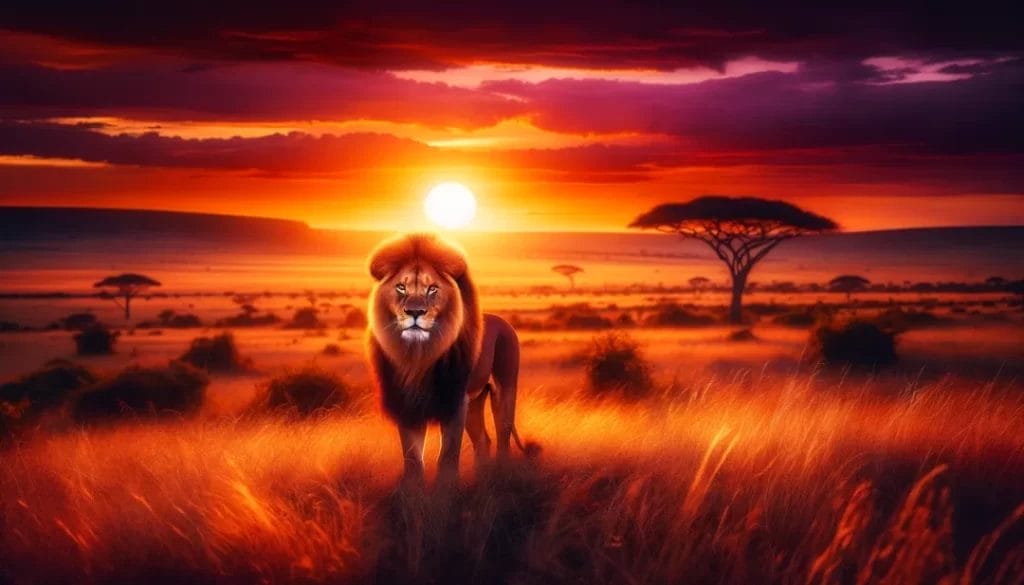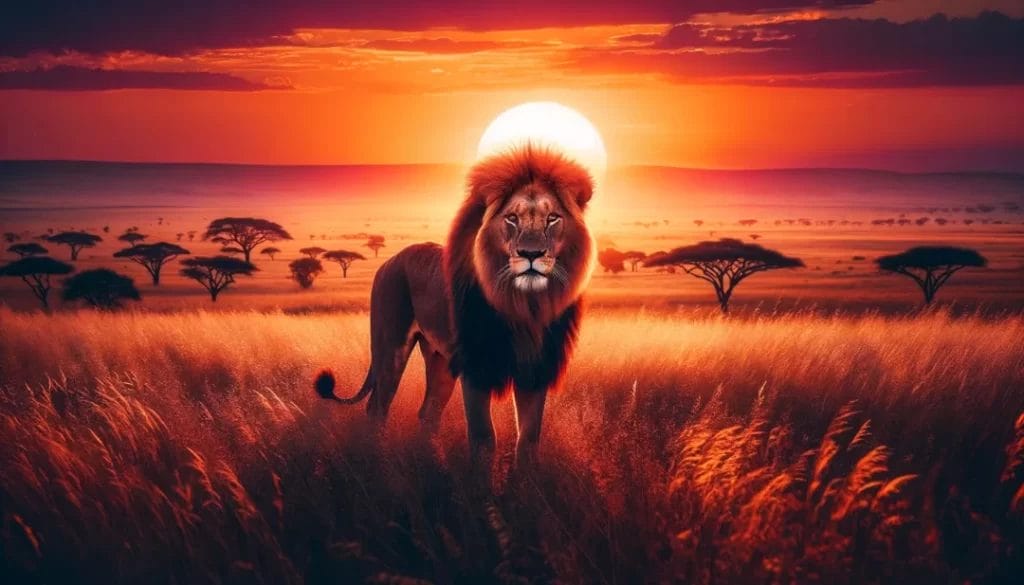Lions are majestic creatures that have captivated human beings for centuries. Known as the “king of the jungle,” lions are powerful and awe-inspiring animals that have a significant presence in our world. They are not only important in the natural ecosystem but also hold cultural significance in various societies and religions. In this article, we will explore the power and presence of lions, their cultural significance, conservation efforts to protect them, their behavior, physical characteristics, hunting habits, social structure, and some fascinating and unique facts about these incredible creatures.
Cultural Significance: Lions in Mythology, Religion, and Art
Lions have been depicted in various cultures and religions throughout history. In ancient Egyptian mythology, lions were associated with the sun god Ra and were seen as protectors of pharaohs. In Hinduism, the lion is the vehicle of the goddess Durga, symbolizing power and courage. In Christianity, lions are often used as symbols of strength and bravery. In art and literature, lions have been portrayed as noble and regal creatures, representing royalty and leadership.
The symbolism and meaning behind lion imagery in art and literature vary across different cultures. In Western art, lions are often depicted as fierce and powerful creatures, representing strength and dominance. In African art, lions are often portrayed as symbols of wisdom, courage, and protection. In Chinese culture, lions are seen as guardians and protectors against evil spirits.
Conservation Efforts: The Importance of Protecting Lions and Their Habitat
Despite their cultural significance, lion populations have been declining rapidly over the past few decades. According to the International Union for Conservation of Nature (IUCN), lions are currently listed as a vulnerable species. The main threats to their survival include habitat loss due to human encroachment, poaching for their body parts, trophy hunting, and conflicts with humans.
To protect lions and their habitats, various conservation organizations and initiatives have been established. One such organization is the African Wildlife Foundation (AWF), which works to conserve lion populations and their habitats through community-based conservation programs, anti-poaching efforts, and education. Another initiative is the Lion Recovery Fund, which aims to double the number of lions in Africa by 2050 through targeted conservation actions.
Lion Behavior: Understanding the King of the Jungle
Lions are social animals that live in groups called prides. They are known for their hunting prowess and strategic planning. Lionesses are the primary hunters in the pride, working together to bring down large prey such as wildebeest or zebra. Male lions, on the other hand, are responsible for defending the pride’s territory and protecting the cubs.
Lions communicate with each other through a variety of vocalizations, including roars, growls, and grunts. Roaring is particularly important for male lions as it helps them establish their presence and defend their territory. Lions also use body language, such as tail flicking and ear movements, to communicate with each other.
Physical Characteristics: Anatomy and Adaptations of Lions

Lions are large and muscular animals with a distinctive appearance. They have a short coat of fur that ranges in color from light tan to reddish-brown. Male lions have a mane around their necks, which varies in color from blond to black. The mane serves as a visual display of dominance and helps protect the lion’s neck during fights.
Lions have sharp teeth and retractable claws that they use for hunting and killing prey. Their teeth are specially adapted for tearing flesh, while their claws help them grip onto their prey during an attack. Lions also have excellent eyesight, hearing, and sense of smell, which allow them to locate prey from a distance.
Hunting Habits: The Hunt and Kill of Prey
Lions are skilled hunters that rely on teamwork and strategic planning to bring down their prey. They often hunt in groups, with lionesses working together to surround and ambush their target. Once the prey is within striking distance, the lionesses launch a coordinated attack, using their speed and strength to overpower the animal.
After a successful hunt, the lionesses bring the kill back to the pride, where the male lions and cubs also get to eat. This cooperative hunting behavior ensures that all members of the pride are well-fed and helps strengthen social bonds within the group.
Social Structure: The Pride and Its Dynamics
Lions live in prides, which are social groups consisting of related females, their offspring, and a few adult males. The size of a pride can vary from a few individuals to more than 20 lions. The females in the pride are usually related, such as sisters or cousins, and they work together to raise the cubs and hunt for food.
Male lions, on the other hand, are not usually related to the females in the pride. They join a pride by taking over from an existing male or forming a coalition with other males. Male lions play an important role in defending the pride’s territory from intruders and protecting the cubs from potential threats.
Amazing Facts: Little-Known Trivia About Lions

Lions have many fascinating characteristics that make them unique among big cats. One interesting fact is that lions are the only cats that live in social groups. They are also known for their distinctive roar, which can be heard up to 5 miles away. Another intriguing fact is that lionesses are better hunters than males, as they are faster and more agile.
In popular culture, lions have been featured in movies such as “The Lion King” and “The Chronicles of Narnia.” They have also been depicted in literature, such as in the works of Ernest Hemingway and C.S. Lewis. Lions are often used as symbols of strength, courage, and leadership in these stories.
Unique Facts: Unusual Traits and Behaviors of Lions
While many people are familiar with the basic characteristics of lions, there are some lesser-known facts about their behavior that are quite intriguing. For example, lions are known to sleep for up to 20 hours a day, making them one of the laziest animals in the animal kingdom. This is because they spend a lot of energy during hunts and need time to rest and recover.
Another unique trait of lions is their ability to swim. While they are not natural swimmers like tigers, lions are capable of crossing rivers and swimming short distances if necessary. This adaptation allows them to access new territories and find new sources of food.
Fascinating Facts: Intriguing Insights into the World of Lions
In conclusion, lions are powerful and majestic creatures that have a significant presence in our world. They hold cultural significance in various societies and religions, and their decline in population is a cause for concern. Conservation efforts are crucial to protect these incredible animals and their habitats.
Understanding lion behavior, physical characteristics, hunting habits, and social structure can help us appreciate their unique qualities even more. Lions have many amazing and fascinating facts that make them stand out among other animals. Their power, presence, and importance in our world cannot be underestimated, and it is our responsibility to continue learning from and appreciating these incredible creatures.
FAQs
What is a lion?
A lion is a large carnivorous mammal belonging to the Felidae family. It is commonly found in Africa and some parts of Asia.
What is the scientific name of a lion?
The scientific name of a lion is Panthera leo.
What is the average lifespan of a lion?
The average lifespan of a lion in the wild is 10-14 years, while in captivity, it can live up to 20 years.
What is the size of a lion?
A male lion can weigh up to 190-230 kg (420-500 lbs) and can grow up to 1.2-1.5 meters (4-5 feet) in height. A female lion, on the other hand, can weigh up to 120-180 kg (260-400 lbs) and can grow up to 1-1.2 meters (3-4 feet) in height.
What do lions eat?
Lions are carnivores and their diet mainly consists of large mammals such as zebras, buffalos, and antelopes. They also prey on smaller animals like hares and birds.
Are lions endangered?
Yes, lions are considered to be a vulnerable species by the International Union for Conservation of Nature (IUCN). Their population has declined by 43% in the last 21 years due to habitat loss, poaching, and human-wildlife conflict.
Do lions live in groups?
Yes, lions are social animals and live in groups called prides. A pride can consist of up to 30 lions, including females, cubs, and a few males.
What is the role of male lions in a pride?
Male lions protect the pride and its territory from other males. They also mate with the females in the pride and help in raising the cubs.






